A Novel Seedless TSV Process Based on Room Temperature Curing Silver Nanowires ECAs for MEMS Packaging
Abstract
:1. Introduction
2. Materials and Methods
2.1. Chemicals and Materials
2.2. Synthesis of Silver Nanowires
2.3. Preparation and Conductivity Measurement of Silver Nanowires ECAs
2.4. Fabrication of the Novel TSVs Process
2.5. Characterizations
3. Results and Discussion
3.1. Characterization of Silver Nanowires
3.2. Morphology and Electrical Properties Analysis on the Novel ECAs
3.3. The Seedless TSV Process Based on the As-Prepared ECAs and Properties Analysis on the Fully Filled TSVs
3.4. Extending the Novel Seedless TSV Process to Other Substrates
4. Conclusions
Supplementary Materials
Author Contributions
Funding
Acknowledgments
Conflicts of Interest
References
- Yuan, J.; Jeung, W.K.; Lim, C.H.; Park, S.W.; Kweon, Y.D.; Yi, S. A low-cost through via interconnection for ISM WLP. Microsyst. Technol. 2009, 15, 1273–1277. [Google Scholar] [CrossRef] [Green Version]
- Yang, H.; Bakir, M. 3D integration of CMOS and MEMS using mechanically flexible interconnects (MFI) and through silicon vias (TSV). In Proceedings of the 60th Electronic Components and Technology Conference (ECTC), Las Vegas, NV, USA, 1–4 June 2010; pp. 822–828. [Google Scholar]
- Kühne, S.; Hierold, C. Wafer-level packaging and direct interconnection technology based on hybrid bonding and through silicon vias. J. Micromech. Microeng. 2011, 21, 085032:1–085032:7. [Google Scholar] [CrossRef]
- Wang, T.; Jeppson, K.; Ye, L.; Liu, J. Carbon-nanotube through-silicon via interconnects for three-dimensional integration. Small 2011, 7, 2313–2317. [Google Scholar] [CrossRef]
- Chen, B.; Sekhar, V.N.; Jin, C.; Lim, Y.Y.; Toh, J.S.; Fernando, S.; Sharma, J. Low-loss broadband package platform with surface passivation and TSV for wafer-level packaging of RF-MEMS devices. IEEE Trans. Compon. Pack. Man. 2013, 3, 1443–1452. [Google Scholar] [CrossRef]
- Wang, Z. 3-D integration and through-silicon vias in MEMS and microsensors. J. Microelectromech. Syst. 2015, 24, 1211–1244. [Google Scholar] [CrossRef]
- Hofmann, L.; Dempwolf, S.; Reuter, D.; Ecke, R.; Gottfried, K.; Schulz, S.E.; Knechtel, R.; Geßner, T. 3D integration approaches for MEMS and CMOS sensors based on a Cu through-silicon-via technology and wafer level bonding. In Proceedings of the SPIE 9517 on Smart Sensors, Actuators, and MEMS VII; and Cyber Physical Systems, Barcelona, Spain, 21 May 2015; pp. 951709:1–951709:12. [Google Scholar]
- Menk, L.A.; Josell, D.; Moffat, T.P.; Baca, E.; Blain, M.G.; Smith, A.; Dominguez, J.; McClain, J.; Yeh, P.D.; Hollowell, A.E. Bottom-Up Copper Filling of Large Scale Through Silicon Vias for MEMS Technology. J. Electrochem. Soc. 2019, 166, D3066–D3071. [Google Scholar] [CrossRef]
- Zhang, M.; Yang, J.; He, Y.; Yang, F.; Yang, F.; Han, G.; Si, C.; Ning, J. Research on a 3D Encapsulation Technique for Capacitive MEMS Sensors Based on Through Silicon Via. Sensors 2019, 19, 93. [Google Scholar] [CrossRef]
- Hofmann, L.; Ecke, R.; Schulz, S.E.; Gessner, T. Investigations regarding Through Silicon Via filling for 3D integration by Periodic Pulse Reverse plating with and without additives. Microelectron. Eng. 2011, 88, 705–708. [Google Scholar] [CrossRef]
- Hong, S.C.; Lee, W.G.; Kim, W.J.; Kim, J.H.; Jung, J.P. Reduction of defects in TSV filled with Cu by high-speed 3-step PPR for 3D Si chip stacking. Microelectron. Reliab. 2011, 51, 2228–2235. [Google Scholar] [CrossRef]
- Civale, Y.; Armini, S.; Philipsen, H.; Redolfi, A.; Velenis, D.; Croes, K.; Swinnen, B. Enhanced barrier seed metallization for integration of high-density high aspect-ratio copper-filled 3D through-silicon via interconnects. In Proceedings of the 62ed Electronic Components and Technology Conference (ECTC), San Diego, CA, USA, 29 May–1 June 2012; pp. 822–826. [Google Scholar]
- Au, Y.; Wang, Q.M.; Li, H.; Lehn, J.M.; Shenai, D.V.; Gordon, R.G. Vapor deposition of highly conformal copper seed layers for plating through-silicon vias (TSVs). J. Electrochem. Soc. 2012, 159, D382–D385. [Google Scholar] [CrossRef]
- Shen, S.P.; Chen, W.H.; Dow, W.P.; Kamitamari, T.; Cheng, E.; Lin, J.Y.; Chang, W.C. Copper seed layer repair using an electroplating process for through silicon via metallization. Microelectron. Eng. 2013, 105, 25–30. [Google Scholar] [CrossRef]
- Vartanian, V.H.; Allen, R.A.; Smith, L.; Hummler, K.; Olson, S.; Sapp, B.C. Metrology needs for through-silicon via fabrication. J. Micro/Nanolith. MEMS MOEMS 2014, 13, 011206:1–011206:9. [Google Scholar] [CrossRef]
- Lau, J.H.; Lee, C.K.; Zhan, C.J.; Wu, S.T.; Chao, Y.L.; Dai, M.J.; Cheng, R.S. Through-silicon hole interposers for 3-D IC integration. IEEE T. Com. Pack. Man. 2014, 4, 1407–1419. [Google Scholar] [CrossRef]
- Gambino, J.P.; Adderly, S.A.; Knickerbocker, J.U. An overview of through-silicon-via technology and manufacturing challenges. Microelectron. Eng. 2015, 135, 73–106. [Google Scholar] [CrossRef]
- Luo, J.; Wang, G.; Sun, Y.; Zhao, X.; Ding, G. Fabrication and characterization of a low-cost interposer with an intact insulation layer and ultra-low TSV leakage current. J. Micromech. Microeng. 2018, 28, 125010:1–125010:11. [Google Scholar] [CrossRef]
- Killge, S.; Bartusseck, I.; Junige, M.; Neumann, V.; Reif, J.; Wenzel, C.; Bartha, J.W. 3D System Integration on 300 mm wafer level: High-aspect-ratio TSVs with ruthenium seed layer by thermal ALD and subsequent copper electroplating. Microelectron. Eng. 2019, 205, 20–25. [Google Scholar] [CrossRef]
- Kumar, S.; Greenslit, D.; Chakraborty, T.; Eisenbraun, E.T. Atomic layer deposition growth of a novel mixed-phase barrier for seedless copper electroplating applications. J. Vac. Sci. Technol. A 2009, 27, 572–576. [Google Scholar] [CrossRef]
- Lee, J.Y.; Lee, S.W.; Lee, S.K.; Park, J.H. Through-glass copper via using the glass reflow and seedless electroplating processes for wafer-level RF MEMS packaging. J. Micromech. Microeng. 2013, 23, 085012:1–085012:10. [Google Scholar] [CrossRef]
- Jee, Y.K.; Yu, J.; Park, K.W.; Oh, T.S. Zinc and tin-zinc via-filling for the formation of through-silicon vias in a system-in-package. J. Electron. Mater. 2009, 38, 685–690. [Google Scholar] [CrossRef]
- Gu, J.; Liu, B.; Yang, H.; Li, X. A fast and CMP-free TSV process based on wafer-level liquid-metal injection for MEMS packaging. In Proceedings of the 29th IEEE International Conference on Micro Electro Mechanical Systems (MEMS), Shanghai, China, 24–28 January 2016; pp. 569–572. [Google Scholar]
- Ham, Y.H.; Kim, D.P.; Baek, K.H.; Park, K.S.; Kwon, K.H.; Do, L.M. Analysis of a metal filling and liner formation mechanism of the blind via with nano-Ag particles for TSV (through silicon via) interconnection. J. Micromech. Microeng. 2012, 22, 075013:1–075013:8. [Google Scholar] [CrossRef]
- Khorramdel, B.; Mäntysalo, M. Fabrication and electrical characterization of partially metallized vias fabricated by inkjet. J. Micromech. Microeng. 2012, 26, 045017:1–045017:6. [Google Scholar] [CrossRef]
- Yang, T.H.; Guo, Z.L.; Fu, Y.M.; Cheng, Y.T.; Song, Y.F.; Wu, P.W. A low temperature inkjet printing and filling process for low resistive silver TSV fabrication in a SU-8 substrate. In Proceedings of the 30th IEEE International Conference on Micro Electro Mechanical Systems (MEMS), Las Vegas, NV, USA, 22–26 January 2017; pp. 749–752. [Google Scholar]
- Hai, H.T.; Lee, K.W.; Ando, D.; Sutou, Y.; Koyanagi, M.; Koike, J. Feasibility study of Cu paste printing technique to fill deep via holes for low cost 3D TSV applications. In Proceedings of the IEEE International Interconnect Technology Conference (IITC), Hsinchu, Taiwan, 16–18 May 2017; pp. 1–3. [Google Scholar]
- Khorramdel, B.; Liljeholm, J.; Laurila, M.M.; Lammi, T.; Mårtensson, G.; Ebefors, T.; Mäntysalo, M. Inkjet printing technology for increasing the I/O density of 3D TSV interposers. Microsyst. Nanoeng. 2017, 3, 17002:1–17002:9. [Google Scholar] [CrossRef]
- Yan, Y.; Qian, Y.; Sharif, H.; Tipper, D. A Survey on Smart Grid Communication Infrastructures: Motivations, Requirements and Challenges. IEEE Commun. Surv. Tut. 2013, 15, 5–20. [Google Scholar] [CrossRef]
- Lai, X.; Liu, Q.; Wei, X.; Wang, W.; Zhou, G.; Han, G. A survey of body sensor networks. Sensors 2013, 13, 5406–5447. [Google Scholar] [CrossRef] [PubMed]
- Liu, Y.; Han, W.; Zhang, Y.; Li, L.; Wang, J.; Zheng, L. An Internet-of-Things solution for food safety and quality control: A pilot project in China. J. Ind. Inform. Integr. 2016, 3, 1–7. [Google Scholar] [CrossRef]
- Zhang, Z.X.; Chen, X.Y.; Xiao, F. The sintering behavior of electrically conductive adhesives filled with surface modified silver nanowires. J. Adhes. Sci. Technol. 2011, 25, 1465–1480. [Google Scholar] [CrossRef]
- Wang, Y.H.; Xiong, N.N.; Li, Z.L.; Xie, H.; Liu, J.Z.; Dong, J.; Li, J.Z. A comprehensive study of silver nanowires filled electrically conductive adhesives. J. Mater. Sci.-Mater. El. 2015, 26, 7927–7935. [Google Scholar] [CrossRef]
- Wang, Y.H.; Huang, A.; Xie, H.; Liu, J.Z.; Zhao, Y.Z.; Li, J.Z. Isotropical conductive adhesives with very-long silver nanowires as conductive fillers. J. Mater. Sci.-Mater. El. 2017, 28, 10–17. [Google Scholar] [CrossRef]
- Xiong, J.; Li, S.; Ye, Y.; Wang, J.; Qian, K.; Cui, P.; Lee, P.S. A deformable and highly robust ethyl cellulose transparent conductor with a scalable silver nanowires bundle micromesh. Adv. Mater. 2018, 30, 1802803:1–1802803:9. [Google Scholar] [CrossRef]
- Xu, T.; Chen, J.; Yuan, W.; Liu, Y.; Sun, Y.; Wu, H.; Zhou, X. Self-Assembly Synthesis of Silver Nanowires/Graphene Nanocomposite and Its Effects on the Performance of Electrically Conductive Adhesive. Materials 2018, 11, 2028. [Google Scholar] [CrossRef]
- Yang, C.; Gu, H.; Lin, W.; Yuen, M.M.; Wong, C.P.; Xiong, M.; Gao, B. Silver nanowires: from scalable synthesis to recyclable foldable electronics. Adv. Mater. 2011, 23, 3052–3056. [Google Scholar] [CrossRef] [PubMed]
- Beck, S.; Boger, A. Evaluation of the particle release of porous PMMA cements during curing. Acta Biomater. 2009, 5, 2503–2507. [Google Scholar] [CrossRef] [PubMed]
- Tillet, G.; Boutevin, B.; Ameduri, B. Chemical reactions of polymer crosslinking and post-crosslinking at room and medium temperature. Prog. Polym. Sci. 2011, 36, 191–217. [Google Scholar] [CrossRef]
- Yuhana, N.Y.; Ahmad, S.; Kamal, M.R.; Jana, S.C.; Bahri, A.R. Morphological study on room-temperature-cured PMMA-grafted natural rubber-toughened epoxy/layered silicate nanocomposite. J. Nanomater. 2012, 2012, 760401:1–760401:14. [Google Scholar] [CrossRef]
- Eaton, W.P.; Risbud, S.H.; Smith, R.L. Silicon wafer-to-wafer bonding at T < 200 °C with polymethylmethacrylate. Appl. Phys. Lett. 1994, 65, 439–441. [Google Scholar]
- Ko, C.T.; Chen, K.N. Low temperature bonding technology for 3D integration. Microelectron. Reliab. 2012, 52, 302–311. [Google Scholar] [CrossRef]
- Ahmad, M.; Bozkurt, A.; Farhanieh, O. PMMA-Based Wafer-Bonded Capacitive Micromachined Ultrasonic Transducer for Underwater Applications. Micromachines 2019, 10, 319. [Google Scholar] [CrossRef]
- Liljeholm, J.; Shah, U.; Campion, J.; Oberhammer, J. Through-Glass-Via Enabling Low Loss High-Linearity RF Components. In Proceedings of the 11th Micronano System Workshop 2016 (MSW 2016), Tomsk, Russia, 10–15 May 2016. [Google Scholar]
- Yang, F.; Han, G.; Yang, J.; Zhang, M.; Ning, J.; Yang, F.; Si, C. Research on Wafer-Level MEMS Packaging with Through-Glass Vias. Micromachines 2019, 10, 15. [Google Scholar] [CrossRef]

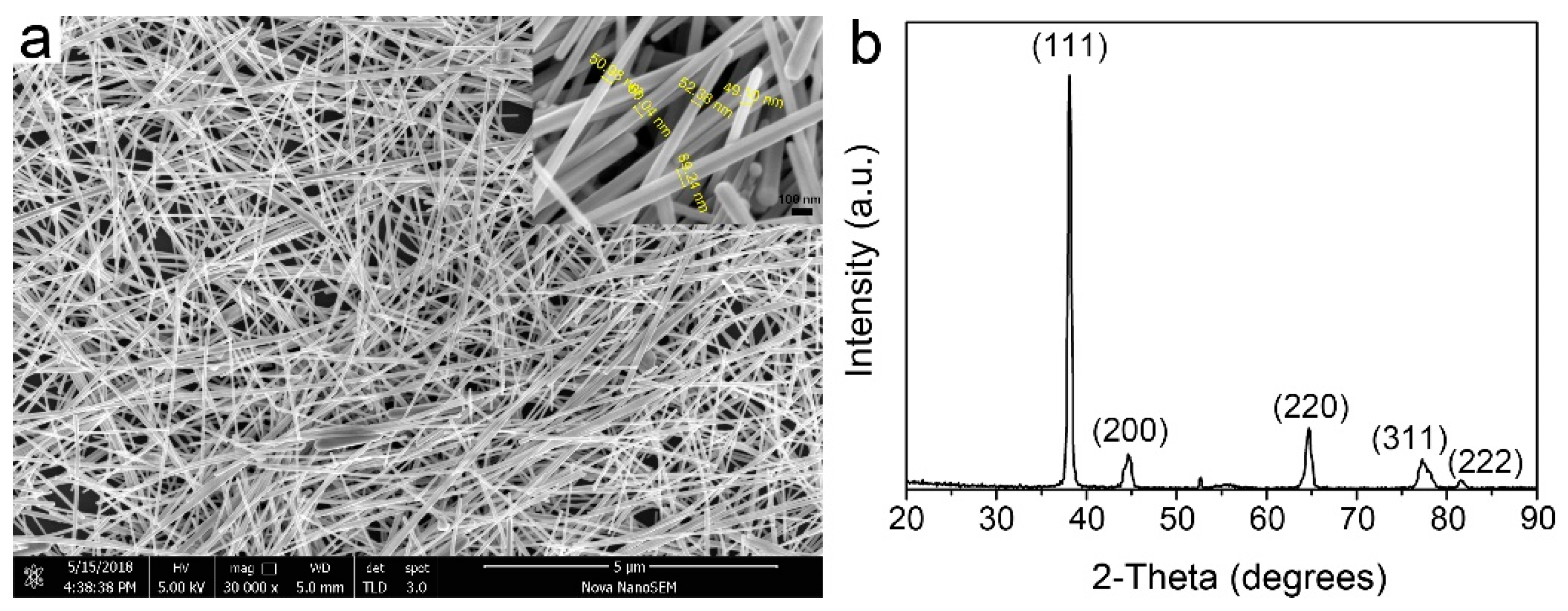
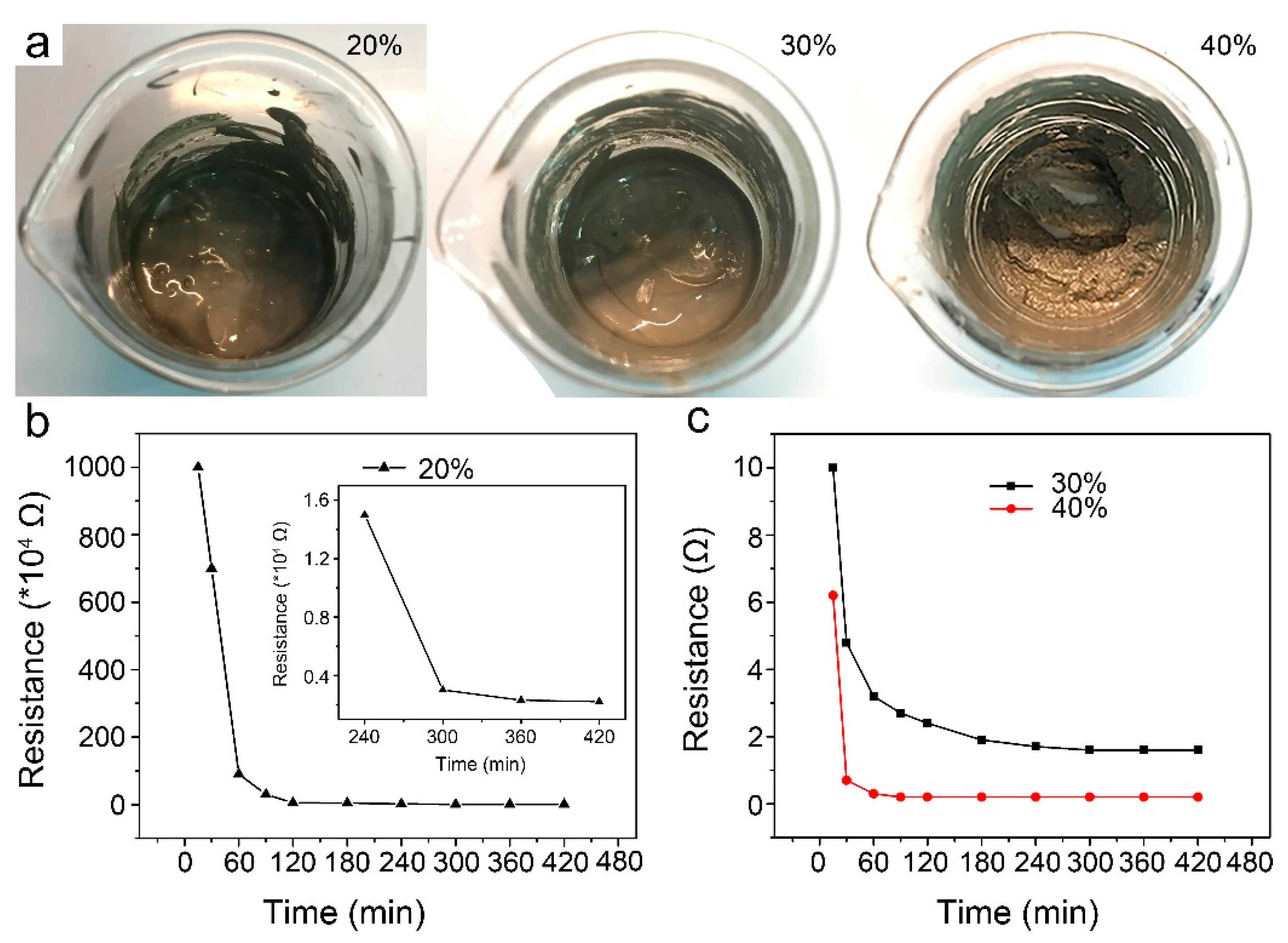
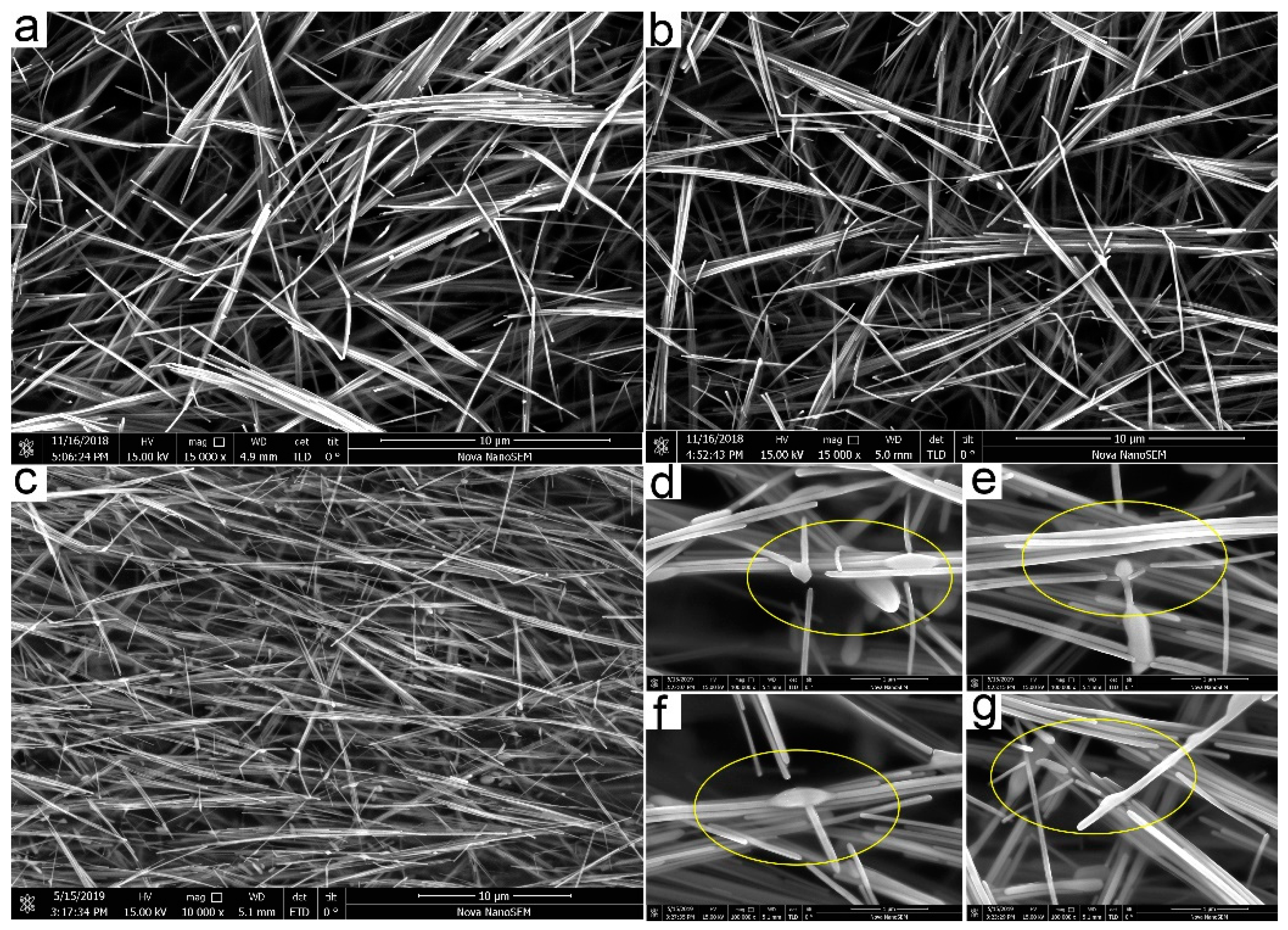
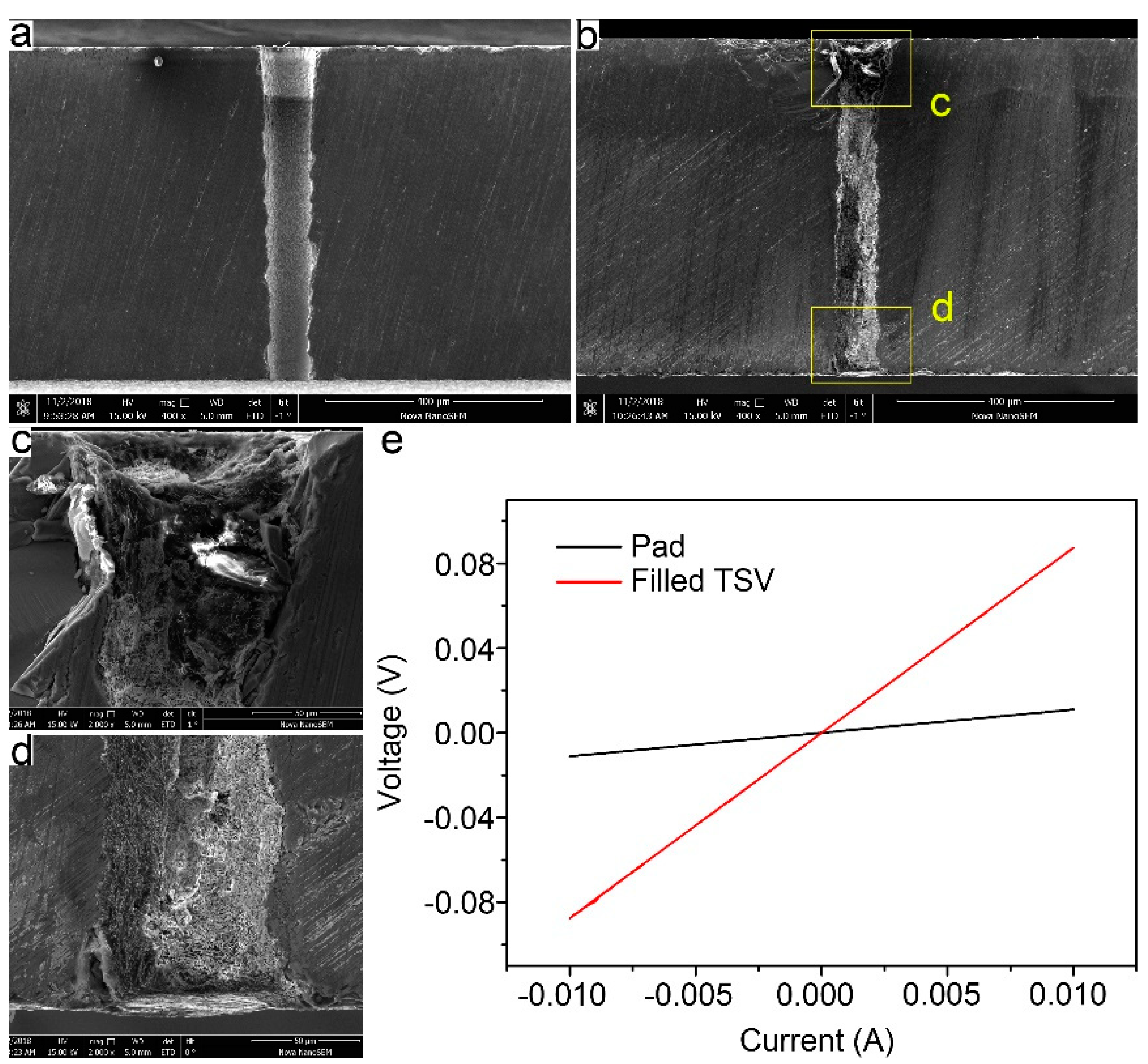
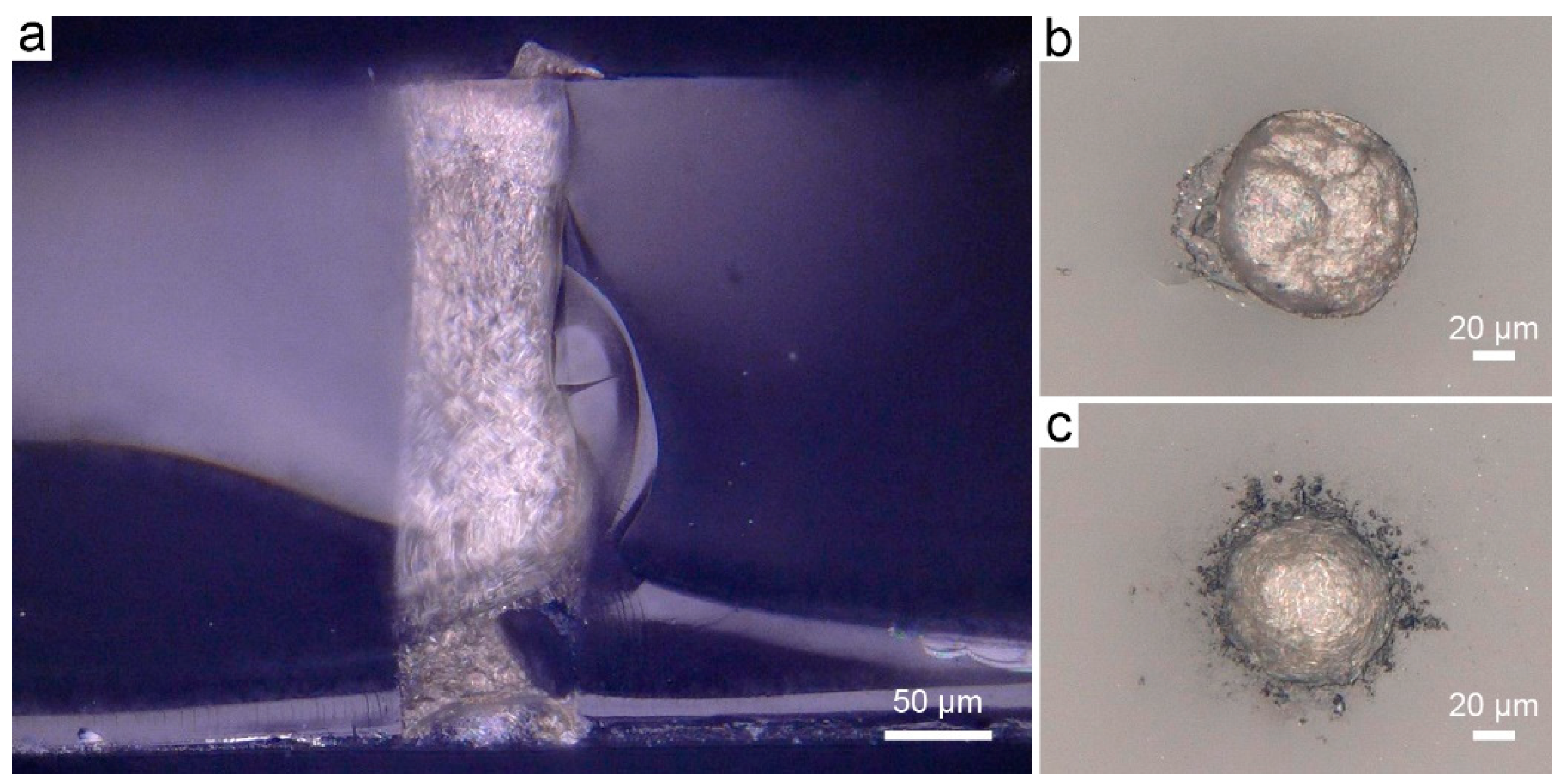
© 2019 by the authors. Licensee MDPI, Basel, Switzerland. This article is an open access article distributed under the terms and conditions of the Creative Commons Attribution (CC BY) license (http://creativecommons.org/licenses/by/4.0/).
Share and Cite
Meng, M.; Cheng, L.; Yang, K.; Sun, M.; Luo, Y. A Novel Seedless TSV Process Based on Room Temperature Curing Silver Nanowires ECAs for MEMS Packaging. Micromachines 2019, 10, 351. https://doi.org/10.3390/mi10060351
Meng M, Cheng L, Yang K, Sun M, Luo Y. A Novel Seedless TSV Process Based on Room Temperature Curing Silver Nanowires ECAs for MEMS Packaging. Micromachines. 2019; 10(6):351. https://doi.org/10.3390/mi10060351
Chicago/Turabian StyleMeng, Min, Lijuan Cheng, Kai Yang, Mingyan Sun, and Yi Luo. 2019. "A Novel Seedless TSV Process Based on Room Temperature Curing Silver Nanowires ECAs for MEMS Packaging" Micromachines 10, no. 6: 351. https://doi.org/10.3390/mi10060351




